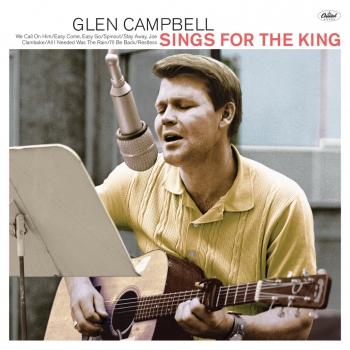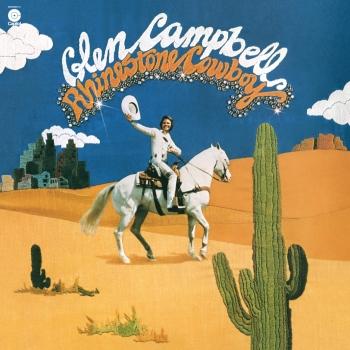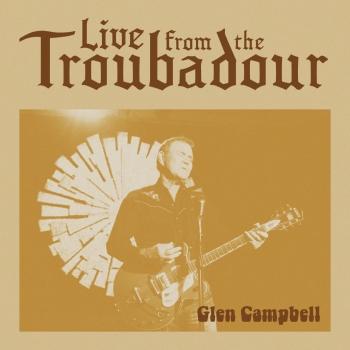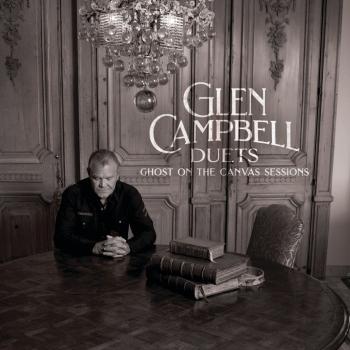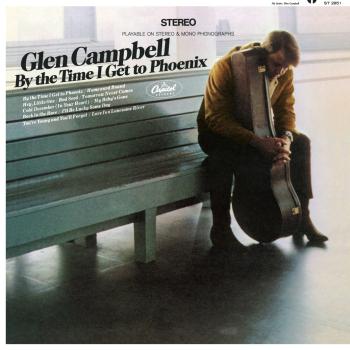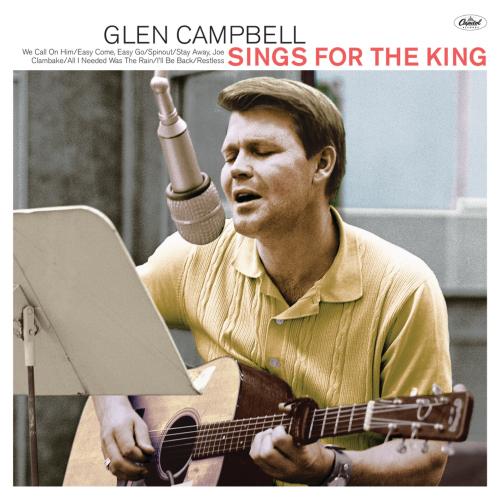
Sings For The King (Remastered) Glen Campbell
Album info
Album-Release:
2018
HRA-Release:
16.11.2018
Album including Album cover
I`m sorry!
Dear HIGHRESAUDIO Visitor,
due to territorial constraints and also different releases dates in each country you currently can`t purchase this album. We are updating our release dates twice a week. So, please feel free to check from time-to-time, if the album is available for your country.
We suggest, that you bookmark the album and use our Short List function.
Thank you for your understanding and patience.
Yours sincerely, HIGHRESAUDIO
- 1 We Call On Him 02:28
- 2 Easy Come, Easy Go 02:16
- 3 Any Old Time 02:41
- 4 Anyone Can Play (Rock Version) 02:36
- 5 I Got Love 02:00
- 6 I’ll Never Know 02:01
- 7 All I Needed Was The Rain 02:30
- 8 How Can You Lose What You Never Had 02:33
- 9 Spinout 02:27
- 10 Magic Fire 02:11
- 11 I’ll Be Back 01:59
- 12 Love On The Rocks 02:06
- 13 Stay Away Joe 01:51
- 14 Cross My Heart And Hope To Die 02:06
- 15 Clambake 02:06
- 16 There Is So Much World To See 02:47
- 17 Do The Clam 02:26
- 18 Restless 02:32
Info for Sings For The King (Remastered)
Capitol/UMe will delight the countless millions of fans of two global superstars with the 16 November release of the “lost album” Glen Campbell Sings For The King.
It features 18 recently unearthed and unreleased tracks from the recordings that Campbell made between 1964 and 1968 for Elvis Presley. The pair’s friendship stretched across three decades, from their first meeting during Elvis’ rise to fame to the days when both were adored worldwide.
Initially intended for Elvis’ ears only, these recordings were fully fleshed out studio versions of songs written by the team of Ben Weisman and Sid Wayne; Weisman is noted as the composer with more songs recorded by Presley than any other, with a total of 57. They also included notable sides such as ‘Got A Lot Of Livin’ To Do’ and ‘Rock-A-Hula Baby.’
Glen Campbell was asked to bring his perfect pitch and ability to match Presley’s vocal pitch and style, so that the songs could be presented to ‘The King’ for his recording consideration. Glen also brings his unrivalled guitar virtuosity to the material.
Campbell undertook the sessions in between others during his time with the famed studio ensemble the Wrecking Crew, as a touring member of the Beach Boys and on his own recordings.
The album opens with a digital duet between Presley and Campbell, the gospel song ‘We Call On Him,’ and features a variety of styles ranging from the country-tinged ‘Any Old Time’ via ballads like ‘I’ll Never Know’ to the rockier ‘I’ll Be Back.’ Campbell begins ‘I Got Love’ in his own style but subtly changes the delivery to Presley’s tone.
Campbell and Presley first met as early as 1956 when Elvis performed in Albuquerque, where Glen had recently moved to join his uncle’s band, Dick Bills and the Sandia Mountain Boys. Music journalist and author Alan Light writes in the album’s liner notes: “With their genre-bending musical exploration and rural Southern roots, it’s no surprise that Glen Campbell and Elvis Presley formed something of a mutual admiration society.”
Campbell later recalled: “Elvis and I were brought up the same humble way, picking cotton and looking at the north end of a south-bound mule. I saw him in the rough,” he said of the 1956 performance. “He was so electrifying.” In 1960, Campbell moved to Los Angeles to find work as a session musician and landed a regular gig at the Crossbow Club, where Presley and his friends would sometimes visit to watch the entertainment from a small private room upstairs.
Long before his own stardom, Campbell was unrivalled as a session guitarist, playing on nearly 600 sessions in 1963 alone. His one appearance on a Presley recording was the memorable guitar on ‘Viva Las Vegas.’ Even after his own breakthrough in 1967, Campbell continued to record songs for Weisman and Wayne in his increasingly limited spare time.
The Presley-Campbell relationship could even have taken another turn in 1969, when Elvis chose him as one of two contenders for lead guitarist in his TCB band. But Glen’s huge success by then rendered him unavailable, whereas James Burton, who famously took the role, was free after the disbandment of Ricky Nelson’s group.
Glen Campbell, Gitarre, Gesang
Digitally remastered
Glen Campbell
From the Wrecking Crew to “Rhinestone Cowboy.” From “By the Time I Get to Phoenix” to “A Better Place.”
Twenty-one Top 40 hits with two hitting No. 1. Six Top 20 albums including chart-topper Wichita Lineman. Twenty-seven country Top 10 singles — spanning 22 years — and nine country No. 1 albums.
Five Grammy Awards, three Grammy Hall of Fame honors and a Grammy Lifetime Achievement Award, seven Academy of Country Music awards and a 1998 Pioneer Award recognition, three American Music Awards, two Country Music Association Awards and a 2005 Country Music Hall of Fame induction, three Gospel Music Association Dove Awards.
Not to mention hosting of one of the era’s most-beloved variety shows, co-star of the original “True Grit” (at the behest of star John Wayne, no less, earning a Golden Globe “most promising newcomer” nomination) and voice of a cherished animated rooster. And today Alan Jackson, Keith Urban, Jakob Dylan and many others cite him as a primary influence and inspiration.
Glen Campbell’s musical and entertainment lifetime, covering over five decades, is unmatched for its prolific breadth, popular appeal – and flat-out musical accomplishment and achievement. His biggest run of hits (“Gentle on My Mind,” “By the Time I Get to Phoenix,” “Wichita Lineman,” “Galveston,” “Rhinestone Cowboy” and “Southern Nights” just to name a handful) put him in the pop elite of the late-‘60s and early-‘70s, erasing the line between pop and country and helping pave the way for generations of others. You could well call him the first countrypolitan star, though the sharecropper’s son from Delight, Arkansas never lost any of the pure country in his soul.
But even at his popular peak, few were aware of the full extents of his credentials as a first-call session guitarist whose picking helped shape Phil Spector’s famed “Wall of Sound” and the Beach Boys’s most creative works (the latter for whom he also became a touring member for a stretch when Brian Wilson first retired from the road in 1964). That’s him creating indelible guitar parts on the Beach Boys’ landmark Pet Sounds album,” Frank Sinatra’s “Strangers in the Night,” the Righteous Brothers’ “You’ve Lost That Lovin’ Feeling” and the Monkees’ “I’m a Believer,” not to mention hits by Elvis Presley, Bobby Darin, Lou Rawls, Ricky Nelson, Merle Haggard, Bobby Vee. And yeah, you can see him backing various artists with the Wrecking Crew as the house band on the legendary “T.A.M.I. Show.”
This background made his TV show, The Glen Campbell Goodtime Hour, a destination for the top artists of the era – but he also used the setting to show off his own skills and those of some lesser-known friends (John Hartford, Doug Dillard) in the regular “Pickin’ Pit” segment with friendly folk-country cutting contests between the players. It was an eye-opening look into American roots music for the mainstream. The combination of talents and personality that made him a TV star enabled him to transcend eras, remaining a hit-maker across decades as well as across genres.
Well-documented troubles and struggles along the way at times took him on less pleasant paths. But through family and faith he overcame them, not just surviving but thriving. And not only has he remained a top touring artist through the years – with sons Cal and Shannon and daughter Ashley becoming key members of his band – but has found fresh approaches and material as well. Working with producer Julian Raymond, in 2008 he released the pointedly titled Meet Glen Campbell, an album of personalized interpretations of songs originated by such vital artists as U2, Jackson Browne, Green Day, Tom Petty, the Foo Fighters and even the Velvet Underground, with musical support from members of Jellyfish, Jane’s Addiction and Cheap Trick’s Robin Zander and Rick Nielsen.
That was followed by 2011’s Ghost on the Canvas, a moving, engaging and inspirational song cycle that traces the arc of his remarkable life, love and faith. With songs crafted by Campbell and Raymond (once again producing) joined by contributions from acolytes Jakob Dylan, Paul Westerberg and Teddy Thompson and guest appearances by such admirers as Smashing Pumpkins’ Billy Corgan, Brian Setzer and members of the Dandy Warhols, the album at once renewed and revitalized the spirit of classic Campbell albums and stood tall alongside them. Shortly after he recorded the album, Glen was diagnosed with Alzheimer’s disease. Undeterred, he embarked on a series of live dates that he dubbed “The Glen Campbell Goodbye Tour.”
USA Today hailed Ghost on the Canvas as “a museum-quality masterpiece,” while Rolling Stone noted: “The years have added an edge to his singing.” He was honored with a star-studded tribute at the Country Music Awards in 2011 and a Lifetime Achievement Award at the Grammy Awards in 2012.
During the Ghost sessions, Campbell took a fresh look at his older material and – for the first time – laid down new vocals for many of his classic, career-defining hits. Producers Dave Kaplan and Dave Darling later took Glen’s vocals and reinterpreted the songs to convey an intimacy that is at once chilling, uplifting, haunting and spine-tingling all at the same time, all of this much to Campbell’s delight. “When Glen heard the results of what Dave and Dave did in reinterpreting these songs, he lit up and was smiling from ear to ear. And I was too.” Kim Campbell says. “We heard these songs and Glen’s voice in a whole new way and absolutely love the results.”
Demonstrating once again that his characteristic warmth and sense of humor are intact, Campbell titled the resulting album See You There, an expression that’s been a trademark of his for decades, but takes on an added poignancy at this stage of his life and career. See You There was released on August 13th, 2013.
This album contains no booklet.









